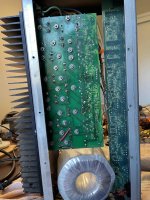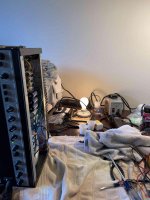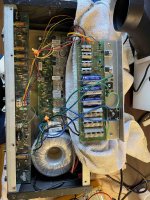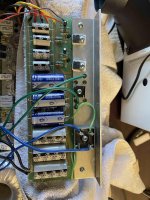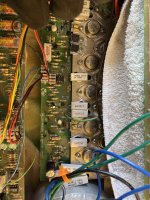I installed the new MJ15022s. They measured ~3000 pf across the base-emitter. I was able to bias successfully, and things looked good (dim DBT). However, when I removed the DBT and attached a known good speaker, magic smoke appeared (and the lights in the room dimmed). It looks like at least R3 on the power supply board fried, and potentially other things. The output transistors still measure ok, so any ideas on why this might have happened? I will replace R3 and recheck the power supply board (with DBT and no load), but I'm not quite sure what to do differently next time. Once the power supply and output transistor bias look good, should I still use the DBT when checking input signal?
If you biased the amp while on the DBT it would be biased WAY too hot on line voltage. The DBT is to check for low current and then removed, very few meaningful things can be done while on the DBT.
Craig
Craig
Ah, I see. So I should follow the below procedure?
1. Replace any obviously burnt components
2. Power up amp on DBT with no load and check power supply voltages (and ensure DBT is dim)
3. Remove DBT and bias amp (still no load)
4. Add load and check signal chain
Do I have that right?
1. Replace any obviously burnt components
2. Power up amp on DBT with no load and check power supply voltages (and ensure DBT is dim)
3. Remove DBT and bias amp (still no load)
4. Add load and check signal chain
Do I have that right?
In between steps 2 and 3:
Run the amp at full output with a LIGHT load. Maybe 100 ohms. This will insure that there are no issues with breakdown voltage and that it won’t oscillate or latch up.
Exercise the bias circuit. Make sure you *can* set it to the target value, and that it can be reduced to zero before hitting it will full line voltage. Leave the bias at zero or close to it.
Play music through it at low volume, WITH a speaker. The bulb should just glow brighter the louder it plays and gracefully drop the voltage with no sudden jumps. Use music, not a sine wave to keep the average power low and let you have more useful peak output while on the DBT.
Pass all that, then move on to full voltage (or variac if you have one). I generally gather a *lot* of useful information while on the DBT.
Run the amp at full output with a LIGHT load. Maybe 100 ohms. This will insure that there are no issues with breakdown voltage and that it won’t oscillate or latch up.
Exercise the bias circuit. Make sure you *can* set it to the target value, and that it can be reduced to zero before hitting it will full line voltage. Leave the bias at zero or close to it.
Play music through it at low volume, WITH a speaker. The bulb should just glow brighter the louder it plays and gracefully drop the voltage with no sudden jumps. Use music, not a sine wave to keep the average power low and let you have more useful peak output while on the DBT.
Pass all that, then move on to full voltage (or variac if you have one). I generally gather a *lot* of useful information while on the DBT.
Thanks wg_ski. What do you recommend for the 100 ohm load? I don't think I have a resistor around that value that can handle much over .25 W...
Also, if I understand this correctly: the DBT should be dim when a speaker is connected but no signal is input, is that right?
Use resistors in series or parallel if you have to. A bunch of 10 ohm 1 watt resistors in series or 1k in parallel will do it. If all you have are quarter watt resistors, you will need more of them. Overloading by a factor of two or three for a five second test won’t hurt anything, but a factor of 10 would be ill advised.
And the bulb should remain dim with a speaker connected and no signal. Unless you’re still putting DC to the speaker.
And the bulb should remain dim with a speaker connected and no signal. Unless you’re still putting DC to the speaker.
Ok, got it. What should I be looking for when running the amp at full output with a 100 ohm load? Bright DBT?
The amp should put out about 16 watts into 100 ohms. The bulb should glow about as brightly as one would expect playing a 16 watt amp through one - lit up some but not bright. With music signal it should stay very dim because the average power will be a couple of watts.
I replaced R3 on the power supply board. With the +/- 15V header disconnected from the power amp board, the power supply voltages look ok (given that a DBT is connected) and the DBT is dim. However, the DBT is bright if the 15V header is reattached to the power amp board. I also smell hot electronics more than before, but that could just be residual from the toasted R3.
Messing with bias resistor R38 doesn't really change the DBT brightness, and neither does reflowing its solder joints (which dimmed the DBT last time). All the connections near R38 seems to be ok (even though the board is crispy in this area) so what do you recommend I check next? Q14 tests ok. I'm a bit stumped.
See attached images of the guts. You can see that this amp has been through a lot over the years (new PT, wires instead of traces on the bottom). Perhaps the PCB is just toast?
Messing with bias resistor R38 doesn't really change the DBT brightness, and neither does reflowing its solder joints (which dimmed the DBT last time). All the connections near R38 seems to be ok (even though the board is crispy in this area) so what do you recommend I check next? Q14 tests ok. I'm a bit stumped.
See attached images of the guts. You can see that this amp has been through a lot over the years (new PT, wires instead of traces on the bottom). Perhaps the PCB is just toast?
Attachments
Last edited:
I'm hung up on the fact that the DBT is bright when the 15V header is connected to the output board, but dim when this header is disconnected. I suppose this is because the +/-15V is powering U1 (353 JFET)? How else can I isolate the issue? I certainly smell more electronics than I used to, so something is cooking.
A '353 can not light-up an incandescent lamp.
If you are *sure* this is only +/-15V, then put your finger on parts until you find a hot one. (15V won't kill a healthy human.)
If you are *sure* this is only +/-15V, then put your finger on parts until you find a hot one. (15V won't kill a healthy human.)
The output board has +/- 85V (and +/- 60V), but the lamp only lights up when the 15V rail is connected to the output board. The bulb is dim when just the 85 and 60V rails are connected.
Q11 and Q12 cannot conduct if they are healthy and if the 15 volt rails are removed. Somehow, Current through this path is initiating an over current condition, perhaps in the output stage. What happens if you short the bias stack? Connect the bases of the upper and lower drivers DIRECTLY TOGETHER and see if you still get a over current condition when the 15 volt rails are brought up. If this is not what’s happening, then the only other thing could be a dead shorted op amp, shorting the 15 volt rails together.
Thanks wg_ski. Forgive my ignorance, but which components are the upper and lower drivers? I should just short their bases with a jumper and power up (with DBT and 15V header connected)?
- Home
- Amplifiers
- Solid State
- Troubleshooting Gallien Krueger 800rb Bass Amp
